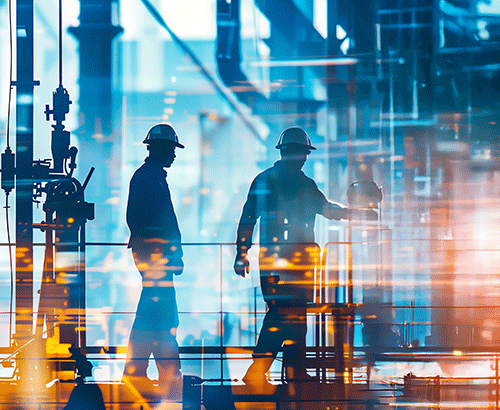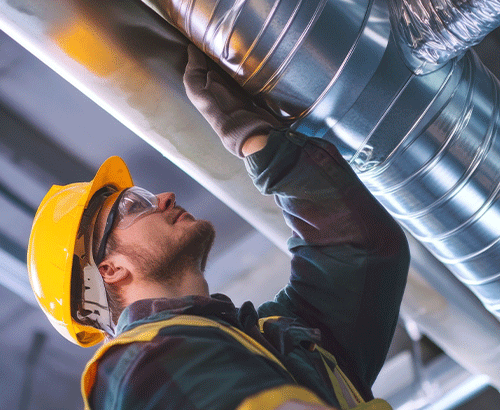Why Contractors Need to Understand Embodied Carbon

Carbon accounting isn’t required on all projects yet, but there are major incentives for early adopters.
The exact language being hammered out at the United Nations climate summit in Glasgow, Scotland, in late 2021 was a topic of debate, but the shared goal was clear: Halve emissions by the year 2030 and set the U.S. on a path toward decarbonization of the economy.
Construction will play a large part in helping reach these goals. Buildings make 40% of total U.S. energy consumption with 29% attributed to building energy use. But this expenditure is a measure of what is called operational carbon — the energy used in heating, cooling and powering buildings.
Add in embodied carbon — the emissions from materials extraction, production and transport; disposal of old structures; construction equipment and activity; and maintenance over the life cycle of the structure — and buildings actually account for around 50% of U.S. emissions.
That means the projects we build today will account for part of our 2050 carbon budget. In February, President Joe Biden announced a task force to promote the use of construction materials with lower emissions as it works to achieve net-zero emissions by 2050. With the government accounting for $650 billion a year in goods and services purchases, that represents significant purchasing power.
While climate deadlines might seem far off, some contractors are prioritizing carbon mitigation in their materials, processes and technology, which experts say can provide cost-saving measures and create a crucial competitive advantage.
Engineers, designers and contractors are particularly crucial to decarbonization because they touch so many phases of the design and construction life cycle, from sourcing materials to design, preconstruction, construction and maintenance, and communicate to owners and subcontractors, making them a conduit for change as well.
In the years ahead, “owners will look for firms that have experience with low-carbon projects, particularly when utilizing best value selection that places an emphasis on sustainability factors,” says Jacob Arlein, chief executive officer at Stok, an environmental company. “Environment, sustainability and governance (ESG) criteria and requirements are growing. It is coming from investors. You’ll see an increase with publicly traded companies conducting carbon footprint assessments. That will be a huge change. This will start with transparency, carbon reporting, then mandated reductions that will impact the carbon emissions of new projects.”
That’s what lies ahead, but there is plenty of evidence that this transition is already in action.
The Carbon Revolution Is Here
The World Green Building Council predicts that as the global population reaches 10 billion around 2050, the building stock will need to double. This implies a huge increase in consumption of carbon-intensive materials and the need for improved building practices.
For example, cement usage could grow between 12% and 23% by 2050, and steel could increase by a third. The International Energy Agency estimates that production of cement alone accounted for 7% of global carbon emissions in 2019.
That means designers and builders will need to look for alternative materials or work with producers who can accurately show they are working to curb emissions. The Energy Transitions Commission expects recycled secondary steel to outpace primary production in the years ahead and has laid out a plan to reduce cement emissions by a quarter by 2050.
“The decarbonization economy is growing rapidly and expanding across almost all sectors of raw materials globally from agriculture to mining,” says Shelley Goldberg, a commodities expert and founder of Invest-with-Purpose, an environmental sustainability consultancy. She points to companies like BHP, which completed the first carbon-neutral copper transaction from its mines in Chile together with Southwire’s processing plant in the U.S., thanks to blockchain-based supply chain traceability and carbon offsets.
For now, carbon capture has not put pressure on commodity futures prices, suggesting that carbon- neutral initiatives will more than pay off over the medium term to long term, especially with the potential for a global crunch on energy in the future. “Nevertheless,” says Goldberg, “I predict that China’s decarbonization may put upward pressure on commodity prices.”
“If you have a history or a role in the design and construction space, you understand how buildings are designed, how they’re built, how things go together and the process for that. And this is just adding the layers to that process,”
-- Stacy Smedley, director of sustainability at Skanska USA Building.
Consumption regulations are still loose in many countries, but demand for net-zero buildings is growing, driven by anticipation of stricter regulations and the adoption of pledges by private enterprises. The net-zero building market is predicted to reach $140.2 billion by 2028, according to research by Polaris Market Research.
RMI, an energy policy think tank, has outlined several key benefits to reducing embodied carbon, including lowering project costs and decreasing materials use and energy consumption. With many building owners pushing their contractors to account for carbon emissions throughout the construction process, understanding best practices for sourcing, what questions to ask and how to quantify embodied carbon will be a skill set for successful construction managers.
Stepping Up as Contractors
As environmental product declarations and life cycle assessments continue to saturate the industry, there is a huge opportunity for contractors and engineers to develop competencies in carbon accounting.
As an architect, Smedley created the Embodied Carbon in Construction Calculator, or EC3, an open resource available through Building Transparency, where she is executive director. Already she notes that private multinationals and city and state governments are implementing incentives for carbon accounting measures.
“The messages that suppliers are getting from Microsoft, Salesforce or Amazon are the same requirements and disclosures that they will see from a federal or state policy, which is good,” Smedley says.
For example, Microsoft requires all vendors to perform environmental reporting, and New York passed rules that provide bid discounts to contractors who can procure low-embodied carbon concrete. These practices, and the data they provide, will saturate states where these requirements exist first, says Smedley.
“You have these pockets of good data,” according to Smedley. “But there are big swaths of the country with lots of smaller suppliers that are engaging in this [even though] no one’s asking them to and it’s that larger lift.”
At this stage, companies need to put in place dedicated staff who can perform environmental product declarations and life cycle assessments, estimating things such as the carbon required to transport materials from a vendor in the country or one overseas.
“There is a steep learning curve, but an investment in sustainability experts will pay off,” says Smedley. “[There is an] urgent hiring explosion in these groups of sustainability professionals to really understand how to start that process.”
Developer Hines is also generating strategies for managing embodied carbon. It has created an internal guide on embodied carbon to begin educating employees on what’s coming and how to manage it. It is also asking others to monitor embodied carbon and environmental protections on new projects.
Understanding how to manage embodied carbon begins during preconstruction with sourcing better materials. This includes:
- Concrete: The carbon cost of concrete can be reduced by seeking increased energy efficiency, alternative fuels, reduced clinker content (i.e., fly ash, slag or calcined clays), alternate binding materials and carbon capture technology. Concrete has a role to play in energy efficiency of buildings, lending itself to geothermal design, for example.
- Steel: Mitigation measures include better scrap recycling, using rebar with a high portion of recycled content, using the high-powered gas leaving the furnace during manufacturing to power other machines, choosing coke dry quenching over water quenching when retrieving materials from the furnace, or considering alternate materials like wood to build structures.
- Copper: Recycled copper takes 80% less energy to produce than raw copper from mining. The European Copper Institute estimates that solar thermal technology and energy management in buildings could save 700 million tons of carbon emissions a year.
- Insulation: Low-or no-embodied carbon productscan replace traditional insulation materials like foam.
- Cladding and finish materials: Products like aluminum and vinyl are more carbon-intensive than functional alternatives like wood and are often chosen for aesthetics. Lower-embodied carbon paint and glazing options are available on the market.
- Wood and other natural materials: Timber, bamboo and other forms of biomass can absorb and store carbon over a building’s life cycle. These are an attractive alternative to carbon-intensive materials like steel and even glass in the case of engineered transparent wood. Growth and harvesting of timber is also a form of sequestration and can offset emissions.
Contractor relationships with materials producers can be key not only in facilitating a transition to less carbon-intensive buildings but also in finding ways to define that value. After working together on eight sustainable timber buildings around the world, multinational real estate group Lendlease recently announced a partnership with Stora Enso, an Italian supplier of sustainable timber, on a timber studio in Milan that will perform research and development and service Lendlease’s $52 billion slate of European development projects.
“Timber is already experiencing a surge in demand and is a material we should focus on when it comes to utilizing low-embodied carbon material,” says Arlein.
How Contractors Can Lead the Way in the Years Ahead
Contractors touch almost every phase of a project. This puts them in the position of gatekeeper for environmental disclosures and reporting on products and designs. Their early involvement also allows them to put in place specific low-carbon or carbon-positive procurement requirements when dealing with trade contractors.
Contractors will also be at the forefront of working with subcontractors to quantify and trace embodied carbon. It’s important to include subcontractors in the conversations about systems being put in place as well as talking directly with clients to address their questions around embodied carbon.
Key questions contractors should consider as the emphasis on decarbonization efforts continues:
- Do we have anyone with expertise in embodied carbon?
- What resources do we need to start tracking carbon emissions in our building processes?
- Do we consider carbon emissions in the design or product selection phases?
- How can we work with our subcontractors on embodied carbon tracking?
- What level of investment can we make now to get ahead of future requirements?
The ways we account for embodied carbon may change in the years ahead, but contractors need to learn how to operate in a decarbonized economy. These measures require not immediate expertise in the field, but a willingness to learn.
Those who invest now in understanding embodied carbon and making changes to how they work with suppliers and subcontractors will reap the rewards long-term by being able to capture more business.
.png)


.png)